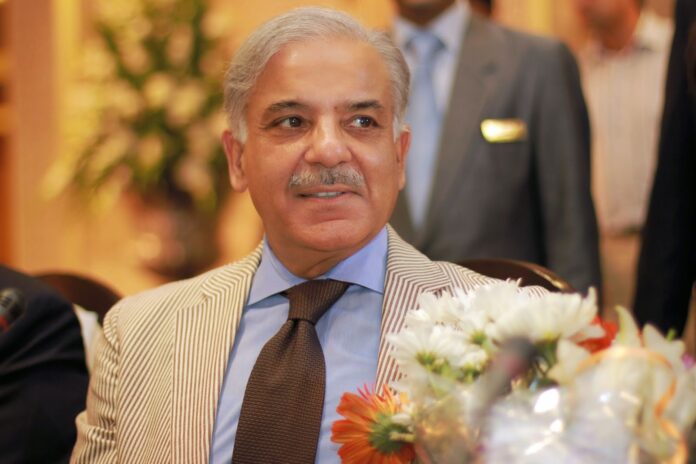At a public rally in Dera Ghazi Khan on Saturday (February 22), Pakistan’s Prime Minister Shehbaz Sharif quipped that if Pakistan can’t zoom past India in progress, his name might be demoted to just another catchy title. He announced a series of transformative development projects aimed at boosting infrastructure and economic growth of the troubled state.
In a viral video, the Pak PM was spotted saying: “If God wishes, we will work hard, we will toil day and night, then a day will come when I will leave India behind or my name will not be Shahbaz Sharif.” A contrasting stance on India Sharif’s statement emerged just weeks after he signalled a readiness to engage in diplomatic talks with India. Earlier this month, during a session of the Pakistan-occupied Kashmir Legislative Assembly on “Kashmir Solidarity Day,” he had advocated for peaceful dialogue to address unresolved issues, including the Kashmir dispute. However, his most recent remarks adopt a more competitive tone, reflecting the current economic and political challenges faced by Pakistan.
PM Sharif was trolled on social media by enthusiasts from both sides of the border. Some suggested he defeats Pakistan’s debt first and some asked him to start looking for another name. While the name of PM Sharif might just be relegated to the “miscellaneous” section of history; his ambitions, however unrealistic, are praiseworthy.
Let us have a look at an objective comparison instead.
Economy:
India boasts one of the world’s largest economies, its GDP dwarfing that of Pakistan much like a flagship store compared to a local boutique. Based on recent figures from the International Monetary Fund (IMF) and the World Bank, India’s nominal GDP is approximately US$3.17 trillion (2022), while Pakistan’s GDP is around US$350 billion. India’s economy benefits from a highly diversified industrial base, including high-tech, manufacturing, and services, contributing to a robust growth rate of roughly 6–7% per annum.
In contrast, Pakistan’s economy is more dependent on agriculture and has struggled with structural challenges, resulting in a more volatile growth pattern. It’s a bit like comparing a multinational corporation to a local enterprise—both have their merits, but the scale is markedly different.
Defence:
India’s defence budget is considerably larger, estimated at around US$70 billion annually, compared to Pakistan’s approximately US$11 billion. While both nations maintain nuclear arsenals, India’s investment in modern technologies, advanced weaponry, and indigenous defence production far outstrips that of Pakistan.
Even though Pakistan’s defence expenditure represents a higher percentage of its GDP, the absolute figures and modernisation initiatives firmly position India ahead, imagine one party with the latest tech gadgets versus another making the best use of a well-worn toolkit.
Geopolitics:
It’s a bit like having a charismatic lead actor (India) and a determined supporting character (Pakistan) in the geopolitical drama of South Asia. Geopolitically, India has carved out a significant role on the global stage. It enjoys extensive diplomatic ties, and active participation in international forums like the G20 and BRICS, and has a growing strategic presence that extends well beyond its immediate region. Pakistan, meanwhile, wields considerable regional influence and benefits from strategic alliances, particularly with China, which bolsters its standing.
Science and Technology:
India’s strides in science and technology are well documented. The Indian Space Research Organisation (ISRO) has achieved international acclaim with missions such as Mangalyaan and Chandrayaan, while India’s IT and startup ecosystems are among the largest in the world, contributing significantly to its economic dynamism. Pakistan is making progress in its tech sector, but its achievements are modest by comparison. Pakistan is steadily making progress in its own tech sector, yet it often appears to be trying to catch up with India.
Not the Best Week for Pakistan
Pakistan has experienced a particularly challenging week, with one setback after the other compounding its ongoing economic crisis. The Pakistan cricket team was eliminated from the Champions Trophy, while the United States cancelled a US$200 million asylum support deal linked to the Pakistan-owned Roosevelt Hotel in New York.
This hotel, which had served as emergency accommodation for thousands of migrants, lost a lucrative US$220 million lease amid backlash from MAGA supporters, inflicting substantial financial losses on an already cash‐strapped nation. In response, Prime Minister Shahbaz Sharif is visiting Baku to strengthen diplomatic and economic ties.
Hopes that China would provide a bailout have been dashed, as it has imposed a debt trap on Pakistan, and funding from Saudi Arabia has also diminished. On 3 February 2025, Pakistan signed an agreement with Saudi Arabia for Development to defer a US$1.2 billion oil import payment by a year, aiming to boost foreign reserves ahead of a March review of a US$7 billion IMF bailout.
As if this was not enough, controversies over misdirection of USAID funds to terror groups have emerged, further complicating Pakistan’s financial stability and deepening its cash crunch.
In closing…
If we imagine this as a race, India’s already speeding ahead in a top-of-the-range sports car, leaving Pakistan comfortably cruising in a dependable (?) hatchback. India’s massive GDP, cutting-edge defence tech, and global diplomatic swagger make the idea of Pakistan leaving it in the dust seem as remote as a snail overtaking a cheetah. Despite Pakistan’s pluck and resilience, its structural challenges and smaller scale mean that the dream of outpacing India is more of a distant, wistful fantasy than an imminent reality. It’s like watching a determined underdog trying to catch up with a world-class champion, an admirable effort, but the gap is just that wide.



